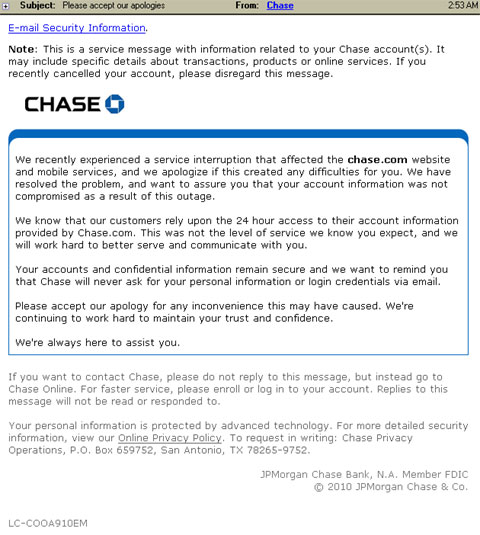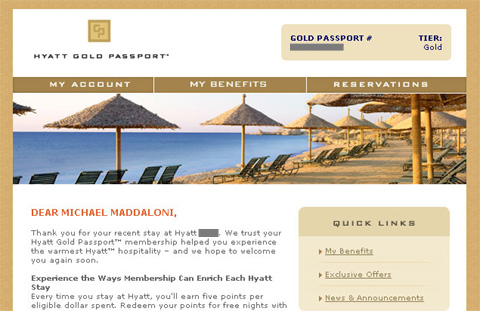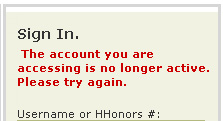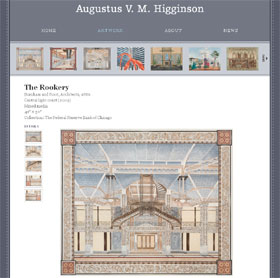Chase Bank Online Outage Apology Unsigned And Nameless
Were you affected by last week’s outage of Chase Bank’s online banking? I was, and so were all of the bank’s customers in the US. Though the money in your account was still accessible via ATM or a branch, you could not access your balances, statements or bill pay over the Web. To add to the over 24-hour outage, there was no announcement from the bank about the problem and no reason given for it either.
Through the outage the login form on the Web site was replaced with a graphic saying online banking was unavailable. Once it was restored, small banner ads on the site linked to an apology Web page for both the outage and lack of communications for a few days. This past Monday morning I received an email from the bank – the only one through this ordeal – apologizing for the outage, and the following is a screen shot of that message.

The text of the message is as follows:
We recently experienced a service interruption that affected the chase.com website and mobile services, and we apologize if this created any difficulties for you. We have resolved the problem, and want to assure you that your account information was not compromised as a result of this outage.
We know that our customers rely upon the 24 hour access to their account information provided by Chase.com. This was not the level of service we know you expect, and we will work hard to better serve and communicate with you.
Your accounts and confidential information remain secure and we want to remind you that Chase will never ask for your personal information or login credentials via email.
Please accept our apology for any inconvenience this may have caused. We're continuing to work hard to maintain your trust and confidence.
We're always here to assist you.
After reading this, there was something glaring at me – no person signed the message.
Where Does The Buck Stop?
You don’t have to look any further than the BP oil spill in the Gulf of Mexico to see a poor example of corporate communications. Once the global oil giant realized the severity of the issue, it put its CEO Tony Hayward out front as the human face of the mechanical disaster. Over the weeks following BP commercials featured employees who were responsible for various aspects of the cleanup. These people didn’t necessarily make the problem any better, but they showed there were people behind the problem.
Even a few months back when Intuit’s QuickBooks Online had several days of outages, emails and blog posts were signed by management. Once again, it didn’t change the situation, but it showed someone was responsible; it showed where the bucked stopped.
This was not the case with Chase Bank. No person – not the CEO, or any Vice President – signed their name or came forward. This impersonal approach was certainly not for lack of staff or resources, so why did nobody own up to the problem?
As a former customer of Washington Mutual, which was taken over by the FDIC and sold to Chase Bank overnight a few years ago, the change to Chase was a huge contrast to me in the approach to serving its customers. WaMu’s free-standing kiosks where you could actually talk to and shake hands with a teller were replaced by tellers behind bullet-proof glass. I could only imagine there would be a person owning up to the issues with their online banking platform if it happened under WaMu’s umbrage. This removal of personal connections with customers is what, as a Chase customer, one has to deal with.
Interestingly, it was during this outage that I moved my business banking to PNC Bank. The decision to do so was not related to the outage, rather it was due to a PNC manager asking me for my business. Also interestingly, this manager was formerly with WaMu and then Chase, and left there for PNC. He knew my business, what I needed, and showed me how much better PNC can accommodate it. Yes, a personal connection was the reason for my change.
What did you think of the bank’s handling of communication? Does it matter to you if there’s personal accountability to such a problem? Please share your thoughts in the comments.
Did you enjoy reading this? You are welcome to subscribe to The Hot Iron by RSS feed or by email.
Ideas To Eliminate And Automate Retail Receipts
 Although I don’t want to come off as repeating myself, paper retail receipts are out of hand. Where such receipts are important and necessary in documenting financial transactions, they can also become a cumbersome mess that can easily get out of control. Now some of you reading this may think I am going to an extreme, and you may not even save and reconcile to receipts. But I always have personally, and I have to for my Web consulting business, as any business owner should.
Although I don’t want to come off as repeating myself, paper retail receipts are out of hand. Where such receipts are important and necessary in documenting financial transactions, they can also become a cumbersome mess that can easily get out of control. Now some of you reading this may think I am going to an extreme, and you may not even save and reconcile to receipts. But I always have personally, and I have to for my Web consulting business, as any business owner should.
Here are a few more ideas I have regarding receipts, which build upon my initial rant conversation on retail receipts. As I don’t have the time, money or energy to act on these right now, I put these out there for anyone to take a stab at. Even if someone is successful and becomes a billionaire with some of them, it will eventually make my life easier!
Receipt File Format Standard – Call it the vCard or iCal standard for retail receipts. This would me an XML file structure for storing all of the data of a receipt into a file. This file will be in lieu of a paper receipt, and identifiable to the retailer by a unique serial number… which most receipts have today anyway. For the sake of discussion here, let’s call it vReceipt.
Deliver vReceipt files by SMS, Email or Web – Once a retailer creates a vReceipt, it needs to get to the customer. It could be delivered to them by any number of methods. If a customer provides their mobile number, it could be sent by SMS. If they provide their email, it could come in a message. The retailer could create a custom QR code for the transaction, and upon the customer scanning it, they could download the vReceipt from the Web. If the customer has a “membership” account with the retailer, the receipt could be delivered via their Web site.
Retailer transmits vReceipt data to third-party service via app – Why not have an app for that? When you check out, your app can show a QR code which can be scanned, then the retailer would transfer the receipt to the 3rd-party service. This service could be Quicken or your bank or a new service you use to track expenses.
Processing vReceipts Makes Expense Tracking Easy – Even though services like QuickBooks Online already sync with your bank, vReceipts can break down the transaction onto its pieces. Were 7 items purchased for work, one was a gift and the rest for the house? A vReceipt will know what was purchased, and will pre-populate the category of an item, or accept whatever override you have for it.
vReceipts App Can Be Used for Returns, Exchanges and Taxes – vReceipts should not just be for figuring out how much you spent on Pringles last year. As a replacement for paper, they should carry all the weight and responsibility of their soon-to-be-defunct paper counterparts. The identifiable information from the retailer should suffice for returns, exchanges, as well as proof for expenses for tax purposes. They would ideally replace having to fax receipts to your employer after you submit your expense report online as well.
What do you think of my ideas around vReceipts? Feel free to compliment, tear apart of use for your own, and your comments are welcome here, which along with vReceipts won’t consume any paper.
This is from The Hot Iron, a journal on business and technology by Mike Maddaloni.
Did you enjoy this? Subscribe to The Hot Iron by RSS/XML feed or Read by Email.
Business • QR Codes • Strategize • Technology • Web Development • (6) Comments • Permalink
Web Site Accounts and Logins Should Never Be Purged
The management of accounts and logins for Web sites can be a task, for both the Web visitor and the Web site owner. For the visitor, they not only need to remember the username and password for many sites, but also secret questions and other identifying information. Then there is the list itself which needs to be protected, as hopefully each login is unique and all passwords are not only different but not easy to remember.
For Web site owners, ideally the Web site has build-in management tools to administering login accounts. These accounts themselves may have additional associated data, like customer detail, order history and frequent customer numbers. Technically, this data can take up space, and many times database administrators will want to archive “inactive” accounts to optimize the database. From a business standpoint, it is often said to also archive or purge similar accounts to not clutter reporting data.
Allow me to 1,000% disagree with both of these stands and say that a Web site accounts and logins should never, ever be purged. Why? Behind these accounts and logins are people or businesses run by people, and where you may not remember them, they remember you! If you remove them, they will remember and it may impact if they do business with you in the future. Or even write about it in a public blog post.
What follows are 3 examples of Web site accounts belonging to me personally and how they were handled. I call them the Good, the Bad and the Ugly.
The Good – Hyatt Gold Passport
Recently my family decided to get away for the weekend and sought out a good hotel rate locally, or what some call a “staycation.” We found an excellent deal at a Hyatt hotel, and I went to their Web site to book it. When I got to the Hyatt Web site, I had to think for a minute if I had an account with their frequent stay program, Hyatt Gold Passport. I checked my list and I did, but for the life of me I couldn’t remember the last time I stayed at a Hyatt.
When I entered the username and password on my list, I was in, and was welcomed by name along with my last stay at a Hyatt, which was a stay at a Hawthorn Suites over 4 years ago. All of my information was correct, as well as the points I earned during that stay. Over 4 years ago! I was extremely pleased, and the online registration was a smooth process as well. After my stay I got this nice email from them – a form email, but still welcome as shown below.

Kudos to Hyatt for not forgetting about me, almost 4 years later.
The Bad – Staples
I have been a customer of Staples since store #6 opened in West Springfield, MA in the late 80’s. As Staples is from Massachusetts, they were the only real choice for discount office supplies, which was not a bad choice by any means. When I moved to Chicago and Staples later opened here, as I was a Staples Rewards member, I got an invite to the grand opening party at their flagship store in the Loop. That store is right around the corner from my office, and I shop there frequently, as well get weekly emails from them and participate in consumer surveys they extend to me. And to keep the FTC at bay, I also own stock in the company.
All of this considered, I was surprised recently when I tried logging into Staples.com to place an online order and my login failed. I was not able to receive a new password either saying my account no longer existed. So I sent a tweet to @staplestweets on Twitter to ask if they purge accounts. I don’t recall the exact time period (nor do I have the links to the tweets) but they said they do purge accounts after a year of inactivity.
The kicker here is that I am not an inactive customer! I shop in the store regularly using my black Staples Rewards Premier card, but hadn’t placed an order on their Web site in over a year. This is a failure on the part of Staples to recognize the true customer experience. If you go beyond purchases alone, I have 5 separate accounts with Staples, one each for Staples.com, Staples Easy Rebates, Staples Feedback Forum, Staples Rewards, and Staples SpeakEasy. When I pointed this out to the people on the Staples twitter account and said they weren’t making it, um, easy for me, they said fair enough. I am sure some of these are run by 3rd-party companies, but still – has anyone ever heard of single sign-on?
I went ahead and recreated my Staples.com account and made the purchase. I hope in the future I never have to do this again, and Staples makes it easier to do business with them.
The Ugly – Hilton HHonors
 The other day my family was looking into hotels and saw one which was a Hilton property. I knew I had a Hilton HHonors account and went to login. I got the strangest error message, as shown, which says in bold red letters, “The account you are accessing is no longer active. Please try again.” What does that mean? If my account is inactive, why would I try it again?
The other day my family was looking into hotels and saw one which was a Hilton property. I knew I had a Hilton HHonors account and went to login. I got the strangest error message, as shown, which says in bold red letters, “The account you are accessing is no longer active. Please try again.” What does that mean? If my account is inactive, why would I try it again?
After staring at the screen for a few seconds, I called Hilton. When the line was answered, I explained the error and gave the rep my account number. She then said matter-of-factly that my account was inactive, period. I asked what that meant, and she said that after a year of not staying at a Hilton or earning any points, my account is marked as inactive and my points are deleted. What? Now sure, there is some brochure I may have received that stated this, but this is the most brutal way to deal with points, even worse than an airline! She then asked if I wanted to reactivate my account, to which I said no – I told her that though it’s their policy I was never reminded of this, and don’t ever want to stay at a Hilton hotel ever again. She didn’t seem to care.
Opportunity Lost
In short, Hyatt gets it, Staples sort of does and Hilton does not.
Staples and Hilton could have easily reached out to me and reminded me that I had not done business with them in a while and given me a special promotion to do so. I get these emails all the time from other vendors, from airlines to restaurants. Staples systems are all separate and thus they do not have an ability to view a dashboard on a customer. Hilton… well, I have no idea what they were thinking, if they were at all.
The cost of acquiring a new customer is much, much greater than keeping a current one. In the retail business, which all 3 of these customers are in, they all have that number – the cost of a new customer. Hyatt made a wise decision to keep a customer’s account active, and thus making a happy customer out of me. I will still shop with Staples and hope they get their act together – literally – and that’s not just because I want my stock value to increase. As for Hilton, I don’t care, as they have lost me as a customer.
Not to mention the cost of acquiring a customer is much greater than any disk storage required to keep that customer’s account on file.
What do you think about Web site accounts being purged? Has this ever happened to you? Please share your thoughts in the comments.
Did you enjoy reading this? You are welcome to subscribe to The Hot Iron by RSS feed or by email.
Someone Has To Write Web Site Content
Someone has to write Web site content. Someone has to write Web site content. I could repeat this statement a million times, as it is something of great concern and passion to me. Why? Let me explain in a brief, true story. Names have been masked to protect the, um, innocent.

There’s nothing like a Web site project completed on time and under budget. My colleague and I were proud of the job we did, integrating a design from a designer who wasn’t a Web designer, but we made it work very well. The site architecture was integrated well based on the up-front analysis and the new site looked great, with one exception – there was no content. Literally, pages were blank! When we presented the site to its sponsor, who was also the one who was supposed to have written the content by now according to the project plan, he was irate. After he gave us a short monologue, it came down to the fact he let this slip from his plate altogether, though he was attempting to pass blame onto us. Oh, and this person was also my boss, the president of the company I was working for at the time, and it was for the company’s own Web site.
Completing content for a Web site can be the critical path to the site’s success. Unfortunately this has happened to me more times than I would like. So how do you ensure it is completed on time, as well as being effective and optimized? Here are some tips to follow.
Define the content - Ideally when you sit down to write content for your Web site this should have already have been completed. The information architecture of the Web site will be the top-line for what content is in the site, and its sitemap will define the pages or organization of the content. Within those pages there may be sidebars, call outs, photos, quotes, videos – whatever you feel will effectively communicate what you want to share with the visitor to your Web site.
Envision the content - Once you have gone through everything in the first step, close your eye and envision what the completed Web site will look like. What do you see in your mind’s eye? As much as pages have been laid out with placeholder text and images, seeing the finished Web page will help you in creating what will go on it.
Outline the content - Now that you know what to write and what it will look like, break down the content into manageable pieces, which is in essence outlining what will be the content of your Web site. Will a page of text have several sections with their own headings? Where will the images go?
Don’t forget SEO - Early on in the process of designing your Web site, you should have done work on the target audience of your Web site and their expectations. This information served as the guide post, spaghetti test or whatever metaphor will help you throughout the entire project. From this early analysis, the keywords and who to optimize the content of your Web site to should have bubbled to the surface or shot up like a rocket. Keep this in mind as you put pen to paper or fingers to keyboard.
Just do it or delegate it - Yes, now someone has to write the content. Hopefully the previous steps have energized you to actually write the content, or scared you into hiring a copywriter to do it for you. But no worries, as with all of this preliminary work done, the copywriter should have all they need to create great content for your Web site.
What may be obvious to some – creating content – isn’t always obvious to all. Have you encountered this yourself, and how did you overcome it? Do you have any tips in addition to those presented here? Please leave a comment and help those whose role it is to create content, whether by choice or force.
Did you enjoy reading this? You are welcome to subscribe to The Hot Iron by RSS feed or by email.
New Web Site Launched For Augustus V. M. Higginson
 Coming off the successful launch of the Spartan Charters Web site last week, my Web consulting firm Dunkirk Systems, LLC is proud to announce the launch of the redesigned Web site for Chicago artist Augustus V. M. “Gus” Higginson.
Coming off the successful launch of the Spartan Charters Web site last week, my Web consulting firm Dunkirk Systems, LLC is proud to announce the launch of the redesigned Web site for Chicago artist Augustus V. M. “Gus” Higginson.
The Web site, at www.AugustusHigginson.com, is a showcase for his work and his career. The artwork section features a gallery of his most recent works as well as some of his past works. As an architectural historian, many of his works pay tribute to great buildings, including The Rookery in Chicago and the Chicago Cultural Center. His works are large-scale, and the site features detailed photos of his works as well as the entire pieces.
 Once again, Dunkirk collaborated with Visible Logic, Inc. and Emily Brackett for this project. Emily’s design not only serves as a great backdrop for Gus’ artwork but also captures the essence of the artist as well. Behind the scenes of the Web site is powered by ExpresionEngine, the great content management system which we at Dunkirk have been working with for years for many of our clients. This provides the ability for editing of all content on the Web site and provides an infrastructure for managing search engine optimization. Integrated in the home page is Gus’ Twitter stream, which you can follow and see photos of his current and past works in process.
Once again, Dunkirk collaborated with Visible Logic, Inc. and Emily Brackett for this project. Emily’s design not only serves as a great backdrop for Gus’ artwork but also captures the essence of the artist as well. Behind the scenes of the Web site is powered by ExpresionEngine, the great content management system which we at Dunkirk have been working with for years for many of our clients. This provides the ability for editing of all content on the Web site and provides an infrastructure for managing search engine optimization. Integrated in the home page is Gus’ Twitter stream, which you can follow and see photos of his current and past works in process.
On a personal note, it was a fun project, especially working with a local client. Most of my clients are not local, though despite this they progress very well, and many times I have met the client after the Web site was completed! It was great to sit at the table with Gus during each phase of the project.
Whether you have an appreciation for architecture, history, or simply want to see a unique perspective on some great places, check out the new Web site for Augustus V. M. “Gus” Higginson.
Did you enjoy reading this? You are welcome to subscribe to The Hot Iron by RSS feed or by email.



